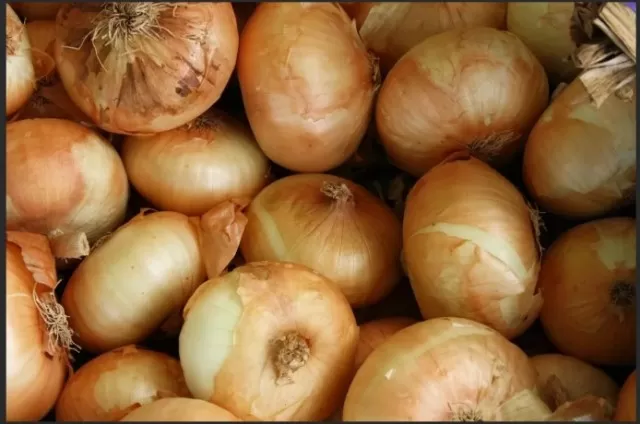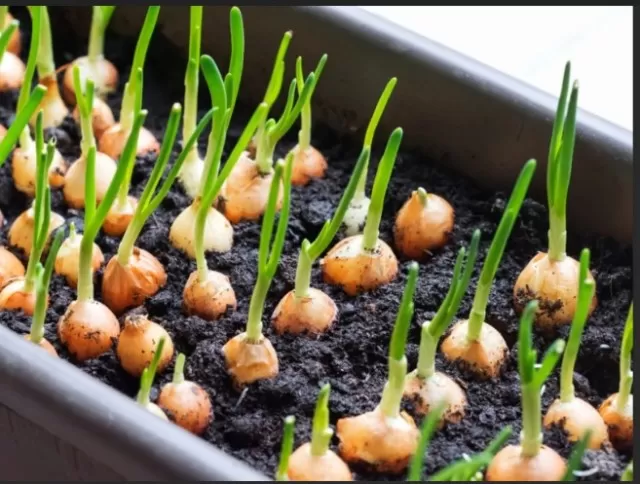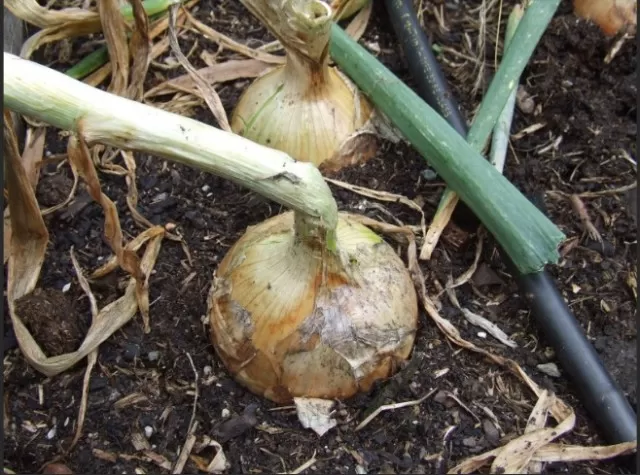Cultivating, Nurturing, and Harvesting Onions. If you’re in search of an effortlessly manageable vegetable to cultivate in your garden this year, consider adding onions to your list. These bulbs are remarkably self-sufficient once you’ve nestled them into the soil and have the added benefit of being quite resilient in full sun with minimal watering needs. The key to a successful onion crop is to ensure they have ample space since onions tend to compete for both water and sunlight. By providing this necessary room, you can look forward to a bountiful and delectable harvest when summer arrives.
Choosing Between Onion Sets and Seeds for Your Garden

When it comes to growing leeks, you have two primary methods to consider: leek sets and seeds.
Niki Jabbour, an expert in gardening from SavvyGardening, and the author of “Growing Under Cover,” explains the differences.
Leek sets are the more commonly used method.
These are essentially immature leek bulbs, usually measuring 3/4 inches in diameter or smaller. You can often find them in bags of 100 during the spring, and they are known for their ease of cultivation.
Planting them is straightforward – simply open the bag and plant each set about an inch deep in the soil. Most leek sets typically take around 90 to 100 days to reach full-sized bulbs.
If you opt for growing leeks from seeds, the process is a bit more involved.
Start by sowing the seeds indoors 10 to 12 weeks before the last spring frost date. Fill pots or trays with pre-moistened potting mix and sow the seeds 1/4 inch deep and 1/2 inch apart.
As the seedlings sprout and grow into grassy shoots, periodically trim the tops to encourage sturdy, stocky plants. Jabbour recommends maintaining the tops at approximately 5 inches in height.
It’s important to provide these seedlings with at least 16 hours of light daily, keep the soil moderately moist, and fertilize them every 2 to 3 weeks using a liquid organic fertilizer diluted to half strength. Growing leeks from seeds requires a bit more attention and care but can offer a wider variety of leek types to choose from.
Selecting the Right Onion Type for Your Garden: A Zone-Based Approach
Choosing the right onion variety for your garden involves considering your USDA hardiness zone, as different onions have specific light requirements.
Onions can be categorized into three groups:.
Short-day onions require approximately 10 hours of daylight.
Intermediate-day onions need 12 to 14 hours of daylight.
Long-day onions thrive with 14 to 15 hours of daylight.
The choice of which onion type to grow hinges on your USDA hardiness zone.
Rebecca Sears, CMO of Ferry-Morse and an experienced gardener, provides some valuable insights:.
Short-day onion varieties, often sweet or mild, are most successful in zones 7 and south.
For zones 5 and 6, intermediate-day onions are the preferred choice.
Long-day onion varieties are best suited for zones 6 and north.
If you’re unsure about your USDA hardiness zone, you can determine it using the USDA gardening zones guide, ensuring you select the most suitable onion type for your specific climate and location.
Kickstarting Your Onions Indoors: A Step-by-Step Guide

If you’re eager to grow onions from seed indoors, following Niki Jabbour’s earlier instructions is an excellent way to begin.
To ensure the timing is right, take into account your specific USDA hardiness zone’s last frost date. This ensures that your onion seeds have sufficient time to mature before they are ready to be transplanted outdoors.
On the other hand, you can also start onions from sets (immature bulbs) indoors.
As suggested by Rebecca Sears, CMO of Ferry-Morse, this method allows you to grow onions indoors throughout the year, making it a convenient option for gardeners with limited outdoor space. To successfully grow onions indoors, keep these essential steps in mind:.
Container Selection: Choose suitable containers with good drainage to plant your onion sets.
Ensure they have enough room for the onions to grow.
Fertile Soil: Use nutrient-rich, well-draining soil for your containers.
This will provide the necessary nutrients for healthy onion growth.
Sunny Location: Place your onion containers in a sunny area of your home.
Onions thrive with plenty of sunlight.
Adequate Watering: Maintain consistent, moderate moisture in the soil, avoiding both waterlogging and drought stress.
By following these guidelines, you can successfully start and grow onions indoors, even if you have limited outdoor gardening space, ensuring a fresh supply of onions throughout the year.
Transplanting Your Onion Seedlings: Timing is Key
For successful outdoor transplantation of your onion seedlings, it’s crucial to wait until they reach the appropriate size.
Typically, you should aim to move your onion seedlings outdoors in the spring when they have grown to a height of about 6 to 8 inches and have developed a few leaves. This size indicates that they are robust enough to thrive in the outdoor garden environment, ensuring a better chance of healthy growth and a bountiful onion harvest.
Planting Onions Outdoors: Tips for Success

When it comes to planting your onion sets or seedlings in your outdoor garden, follow these guidelines for a successful onion crop:.
Planting Depth and Spacing:.
Plant the onions with the pointed side facing up.
Place them 1 inch deep in the soil.
Space them approximately 4 inches apart in rows.
Proper spacing is crucial for bulb development.
Crop Rotation:.
Practice crop rotation in your garden.
This involves planting different vegetable families in different areas of your garden from year to year.
Crop rotation helps reduce the risk of pests and diseases and prevents nutrient depletion in the soil.
A common practice is a four-year crop rotation, where a specific crop family is not planted in the same bed for four years.
Group Vegetables by Family:.
Group your vegetables by family to simplify crop rotation planning.
For example, the “onion family” can include onions, shallots, scallions, leeks, and garlic, as they share similar nutrient requirements.
Proper Spacing:.
Ensure you space your onions properly to allow them to grow healthily and avoid competition for resources like water and sunlight.
Planting them too closely can lead to reduced yields and increased competition.
Overcrowding can also limit air circulation, promoting the development of diseases like botrytis and downy mildew.
Recommended Spacing for Common Varieties:.
For common onion varieties like red burgundy and sweet Spanish yellow Utah jumbo onions, plant them about 3 inches apart in rows spaced approximately 18 inches apart.
By following these steps and guidelines, you can improve your chances of successfully growing onions outdoors, ensuring a healthy and bountiful onion harvest.
*The information is for reference only.